Last Updated on May 25, 2021 by Holly Anne Dustin
Contents
Build a Relationship through Communication
Cat communication leads to relationship. Communicating with your cat will reinforce the bond between the two of you, improve your relationship, and make your new role of cat slave more fulfilling.
Cats are not aloof, anti-social, animals, according to a recent study done at Oregon State University. They are as expressive as dogs but they are much more subtle about it. Cats are introverts while dogs are the extroverts of the pet world. You can train your cat as you develop a relationship with him but it is not the same as training a dog.
Cats Communicate Differently Than Dogs
Dogs like leadership and partnership, cats like to be the leader. They think more like humans, motivated by peer pressure and friendship in a mutually respectful relationship. A cat won’t perform just because you asked. He needs to know what is in it for him.
Cats do not understand punishment but they respond to rewards and praise. Successfully training a cat involves getting him to think doing (or not doing) what you want is his idea. Doing so requires understanding what cats need to thrive, learning their body language and respecting your cat.
If you are a first time cat parent, especially if you have lived with dogs, know that you can’t apply your knowledge of dogs to cats. If your dog rolls over and shows his tummy and you rub it, he’ll love it. Do that with a cat and you will get bitten.
A wagging tail in dogs means let’s be friends. A wagging tail in cats means I’m angry, back off! A cat communicates with his whole body. You need to see the whole picture to understand what your feline friend is trying to tell you.
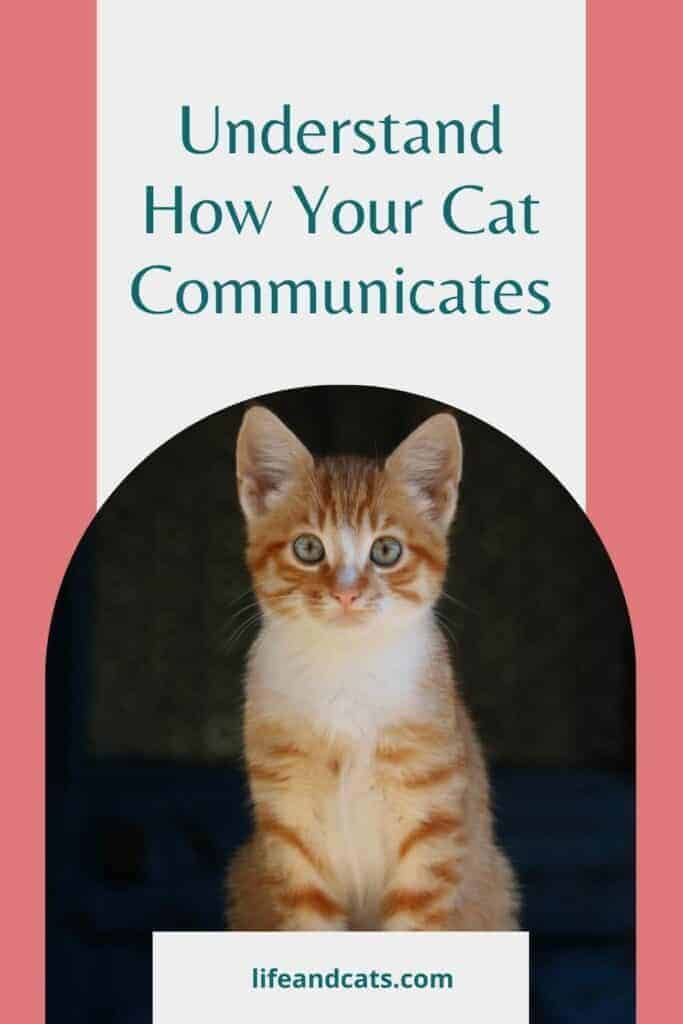
Body Language
Your cat’s facial expressions, body postures, and tail movement show his mood. A relaxed, contented cat will have his tail curled around himself, his eyes will be half closed, his ears will be forward and he’ll be purring.
If something frightens him, his ears will flatten, his pupils will dilate and his fur will fluff out. He might lick his lips. If he gets furious, his eyes will be dilated, his ears will be flat to the side of his head, his whiskers will be forward and he might bare his teeth, hiss or growl.
The key to cat communication is to observe the whole picture. Remember, cats are subtle. A cat with an arched back could be frightened and angry or it could be welcoming your touch.
If your cat is laying on his back or side displaying his vulnerable mid line, it is the cat equivalent of a hug according to Jackson Galaxy, but if you respond by petting him, he’ll bite or roll around your hand in a scratching, biting, “furry bracelet”.
That same side laying cat might be getting ready to spring at an opponent. How do we know? Look at the big picture, their fur, their ears, their tail, their eyes.
Tail:
A straight up tail, or a tail that is up with curled tip, is a sign of a happy cat. If the tail is twitching, kitty is excited or anxious.
A wagging, lashing, flapping tail is a warning. That cat is irritated or annoyed. The more the cat lashes its tail the angrier he is getting. Think of it as yelling at you.
A fluffed out tail curled down shows aggression. The classic Halloween cat posture is not a sign of anger but of fear aggression. Kitty is making himself as big as possible to scare off whatever is threatening him. The opposite is the submissive fear pose. The cat tucks his tail down under their body to make himself as small as possible.
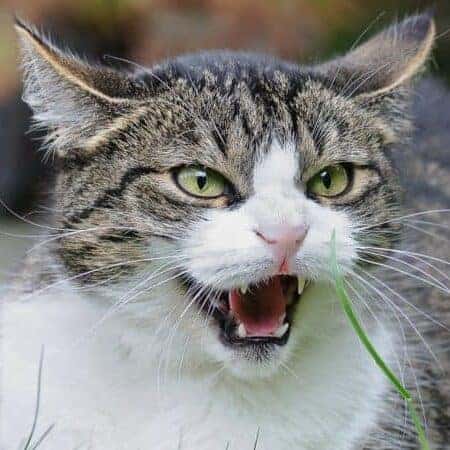
Ears:
Kitty’s sensitive ears are another sign of his mood. He can swivel his ears 180 degrees. You will see cats turn their ears to gather more information about their environment. If his ears are swiveling and forward he is playful, attentive, ready to interact with you.
If he flattens his ears to the side, he’s nervous. And in the classic “airplane ears” pose, kitty will pin his ears back against his head. He’s telling you he is angry or terrified. A kitty with pinned back ears is one to be wary of. Don’t reach in to pet him.
Eyes:

Cat eyes are legendary aren’t they? They can also tell you so much about what your cat is thinking and trying to tell you. Cat eyes are big and round with even pupils. Those pupils will be what you want to keep watching. When they narrow to slits it shows anger or fear, or pleasure. Kitty’s eyes will contract right before he attacks his toys (or prey.) If he narrows those eyes and squint, it’s more a signal of aggression. The squint will protect his eyes from his opponents claws. Dilated pupils also shows fear or excitement. Dilated eyes accompanied by growling or hissing is a sure sign of anger or aggression.
Your cat will “kiss” you with his eyes. Anyone who has ever watched anything by Jackson Galaxy will have heard of the “slow blink.” You can blink back to your cat and share the signs of affection, trust and love. Once you have exchanged that first slow blink you know you can build the relationship.
Another reason so the slow blink is important is that direct stares are threatening to cats. We humans may find eye contact appealing and relationship building. Cats, not so much. Ever try to take a picture of a cat and have it stop whatever cute thing it was doing and walk into the camera? A cat who realizes he is being observed is likely to stop doing what he’s doing and check out the situation.
Whiskers:
Cat whiskers help them navigate their spaces. But they also help with cat communication. When a cat is relaxed and friendly, he holds his whiskers straight and slightly to the side. The more interested the cat gets in things around them, the more the whiskers “prick” forward until they are in front of the muzzle. His muzzle will also get bigger looking. A scared cat’s whiskers are flat back against his face.
Other Means of Cat Communication
In addition to their body language cats communicate through their senses as well. We need to be aware that they are trying to communicate with us, and that the message we are receiving is not necessarily what they are trying to send.
Smell:
The sense of smell is one of the main methods cats use to communicate with and interact with their world. Scent is the first cat communication kittens learn. They learn the scent of their mom and the mix of her scent and the rest of the litter.Each kitten will have a preferred place to nurse. The scent mix makes it “theirs”.
A cat’s sense of smell is 14 times as sensitive as that of humans. Their sensitive noses tells them a lot about their environment and the others living there with them. They send out messages through scent glands in their chin, foreheads, the top of their tail and their paws. They deposit their scent on furniture by rubbing up against things. If they live with other animals, they will rub against them as well. They even rub on you to blend you into their scent group. If two cats-or a cat or dog–share a sleeping spot, they will both deposit scents. This creates a group scent. Grooming both animals with the same brush will help accomplish the same thing. This helps the cat bond with his family, animal and human.
Scratching:
Another method of cat communication is scent marking. The cats’ efforts are not often appreciated by their humans.
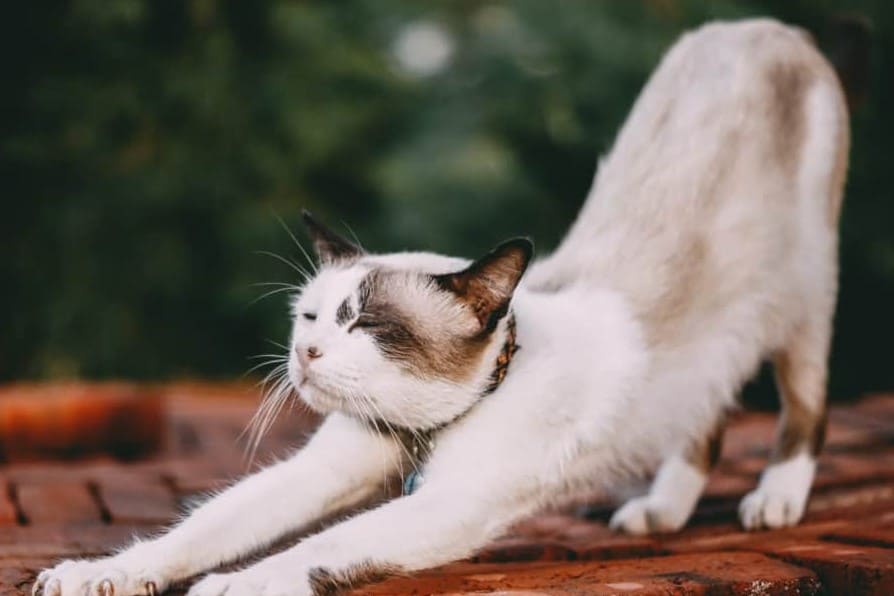
This post may contain affiliate links. Life and Cats is a member of the Amazon Associates program and as such we earn a small commission when you shop through our our links and banners. It doesn’t change the amount you pay. You can read our full disclosure policy here.
Cats use the scent glands in their paws to mark their territory through scratching. So cats NEED to scratch (Why is my cat scratching?). They are not trying to wreck your furniture or make you mad. Your kitty is trying to communicate his presence to the rest of the family. You’ll notice a confident cat will scratch more than, and in front of, a subordinate cat.
This isn’t something you can prevent, so it is a matter of communicating to your kitty “please don’t scratch on my couch or door frames. Look, I got you this awesome cat tower and these scratchy toys and cardboard scratchers. These are way better than the couch.” It doesn’t require spray bottles or cans of coins to make it happen. Remember cats don’t respond to punishment. Add catnip, treats, and positive reinforcement when Kitty uses the tools you have given him. Make the couch less desirable, throw a blanket over the end or cover it with sticky tape or Clawguards. He will figure it out.
House Soiling:
The other unappealing way that cats communicate with us is via urine and feces. Cats will use their waste to mark their territory. Neutering them will help, but neutered males and females can spray.
In addition, cats might pee outside the box. This differs from spraying. Spraying is talking to other animals, dogs and cats in a home with multiple animals, or animals outside they see through the windows. House soiling is another issue. Cats that house soil are trying to communicate with their humans.
The message is I’m not happy. Maybe his box isn’t clean enough, or there aren’t enough boxes in the house. Maybe you use a super scented litter and it offends his nose. Or he hates the cover on his box or the weird motorized thing he’s supposed to pee in. He might also be trying to tell you he doesn’t feel good and needs to see the vet.
If he is peeing on the couch, your bed or your clothing, gross as it is, he is not trying to upset you. He is trying to blend your scent and his own to give him a sense of security. It is a message that something is stressing him out. You’re his safety net and he’s feeling the need to be close. Getting mad will not help and might make things worse.
Find out what is stressing him out. Make sure he has adequate access to litter boxes in a set up that works for him. A lot of litter and boxes are designed for human considerations but are not ideal for the cats that will use it. It is important that the cat is comfortable with the litter box arrangements if you want to prevent problems. It is better that the humans adapt than try to force the cat to do so.
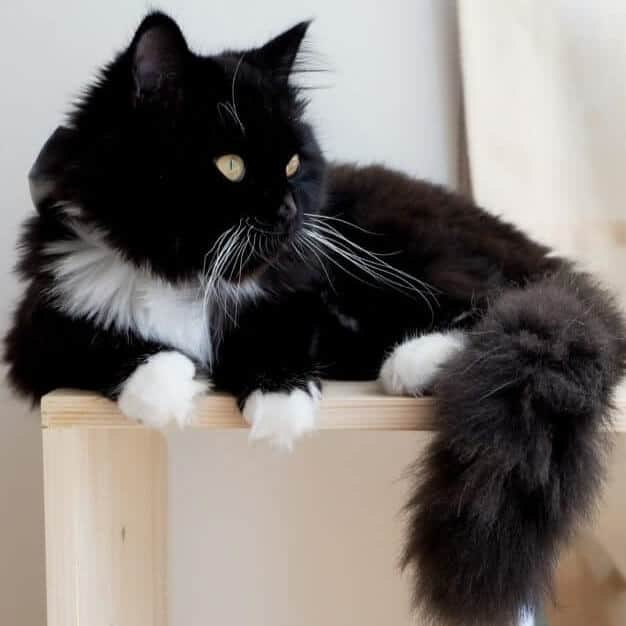
Touch:
Touch is another method of cat communication. Rubbing against your ankles, or against another cat, is like a greeting. “You’re back, I missed you!” It could also be an ownership claim, “this human is mine don’t interfere.” When your cat wraps his tail around you, consider yourself hugged.
We’ve all heard of head butting, otherwise known as bunting. It signals friendliness and affection. Cats will head butt each other and they will head butt their human friends. Watch cats that are acquainted when they meet up. They’ll touch noses and sniff each other’s face. It’s like saying hello and confirming someone’s identity. You can reproduce this moment with your cat by offering him the tip of your finger to his nose.
Mutual grooming develops the group scent, but also shows affection. Your cat licks you because he loves you.
And any cat lover knows the joy of having their feline friend curl up in their lap, purr and start kneading or “making biscuits.” Perhaps that is the ultimate sign of a really happy kitty.
Voice:
Cats have a wide range of vocalizations. They make around 100 sounds compared to a dog’s 10. Cats reserve most of their verbal interactions, other than hissing and growling, for communicating with humans.
Meows come with differences in pitch, intensity, frequency and volume to reflect Kitty’s emotional state and whatever physical need he is expressing. Listen to your cat. He doesn’t just meow so you’ll feed him. He’ll have a feed me cry, a play with me cry, and where are you I need you cry, etc.
As we respond to our cat’s vocalizations we develop a language and communication between us. That develops routines. He asks for what he wants, we reply, and he learns. The more we communicate the better the bond between us.
Besides the meows, cats will purr as a way of asking for care. He’s saying, “don’t go anywhere, I need something.” Cats purr when they are happy and when they are in pain.
If you have ever spent time with a mother cat and her kittens, there’s a high pitched chirping or trilling sound she uses to speak to the babies. If your cat is chirping at you he wants you to follow him. Ask him to show you what he wants. He will.
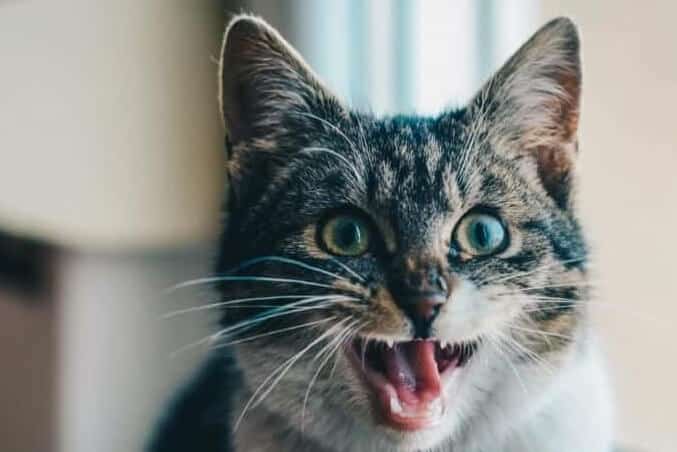
There are the chitters of an excited cat that sees birds or squirrels out the window, their hunting sounds or songs. My Treeno has a special song he sings to his catnip pickle as he carries it around the house. I always hope it is just the toy he’s bringing me when I hear him in the hall at night. Hissing, growling, and screaming are aggressive sounds that happen in mating or fighting. Yowling or howling shows distress.
Grow Your Bond with Your Cat…
and give your cat the best life possible.
You will receive access to a subscriber-only resource library of free and paid cat care guides and printables, and our “mews”-letter filled with more tips, ideas, and cat-related news.
Develop the Bond
The more you speak with your cat the better you will understand him and he you. The time you spend teaching and training your cat enhances that relationship. Consistency and routine is important. Combining vocal cues, gestures, repetition and reinforcement works to train cats as well as it does with dogs. Clicker training is also very effective with cats.

Wonderful, informative article! Cat behavior is one of my favorite things to explore. So much so that one day, after my cat Mia, who was otherwise a shy cat who did not enjoy being held, decided to nap on my head toweled head as I got out of the shower, I was inspired me to write the book “Makin’ Biscuits – Weird Cat Habits and the Even Weirder Habits of the Humans Who Love Them.”
I’m putting that on my to read list!
I read this and giggle… I think Chihuahua’s may be part cat. seriously … down to the tail swishing…LOL
Love it
I’m still learning how to read cat body language. I do know that when they’re all puffed up and hissing at Mr. N, we should cross the street!
Definitely!
I love this post. Every time I read about a different type of communication, I stopped to see what the girls were doing. I’m still trying to figure out Brûlée
Keep talking to her – she’ll talk back more. I don’t get my Tiger very well either.
Great post. Ah this brings back great memories of head butts and slow blinks from my furballs Precious and Dusty. Morning snuggles with purrs were my favorite. Thanks for sharing this informative post.
Nothing like morning purrs and snuggles. Treeno and I start every day like that.
This is such a great article on kitty communication – so much detail – it’s amazing. I must admit, I learned a lot!!
Very interesting and informative. I wish more people would take time to learn behaviour. I love that a cat on their back is like a hug. Also appreciate you pointing out that cats do not understand punishment. We’re for positive reinforcement – no matter the species. Great post!
It’s interesting how different species use different “language.” I read about the differences in Dr. Coren’s article; particularly the differences which are at the root of misunderstandings when the species are not used to being around each other.
I remember reading that punishment is ineffective because a cat has already forgotten the event anyway. But you try telling that to some people!
Great post and people need to read this, its important!
Thank you – I wish people could get it
This is an excellent point, and I love that you say that your cat doesn’t understand punishment. I hope people really learn from that line. I can tell a lot about what my cats are thinking/saying by their eyes and tails – and by Lexy bringing me 10 toys during the night while singing the song of her people!
I soo wish that people would understand that trying to punish their cats isn’t going to solve whatever the problem is. If they can work from the point of relationship and partnership it works better.
I’ve only had one cat, but he was really easy to get along with.
Most are. Unless it’s my Shadow lol
I have lived with one cat and it is true that they are completely different to dogs. Interaction was always on his terms, although it used to make it very special when he came over to you and settled down on you. Very thorough post about communicating with cats. Well done.
Thanks. Yes, when the connection happens it’s the best!
I absolutely love this and the analogy that dogs are children and cats are like friends. It is true I have 4 cats and 1 dog. And the cats really need more time to establish the relationship.
Fantastic post, although I had cats in the past and learnt the hard way sometimes it is always great to read and reflect back at the mistakes I made innocently and will know for the future if I ever get another cat, thanks
I think everyone learns the hard way at some level – we all offend our human friends innocently now and then, same thing with a cat. Luckily they forgive.
This is great information, thanks for sharing. I love Jackson Galaxy, I watched his show a lot. I remember him talking about the Slow Blink!
Love & Biscuits,
Dogs Luv Us and We Luv Them
What a great, detailed article on kitty communication. I no longer consider dogs “pack animals” since they are not wolves at all and don’t act like them…but that’s a topic for another day and post *s*. People do tend to understand dog social dynamics more readily perhaps because our social structures are pretty similar. Most folks consider dogs to be more social–so thanks for pointing out how social cats are as well (just in a different way!). Cats are mysterious creatures but fascinating as well, and thanks for shining some light on the subject.
Dogs relate to people differently, they like leadership. Maybe not a pack but a hierarchy, maybe like the military. Cats negotiate. 😺
Great tips and perfect for the new and experienced cat parent! My cats were great at communicating, particularly when one of them, Mini, was fed up with being petted. She’d smack you on the hand, and boy did that catch my little nephew off guard he started crying. I had to explain, okay lie, that she was just saying hi or whatever I said at the time!!
Cats are definitely much different communicators than dogs. More subtle, more independent, more “moody”. They know what they want, when they want it, and they don’t take sh*t. My cat goes from happy and rubbing on your for love to “that was one too may pets! Time to swat or bite and run away” LOL